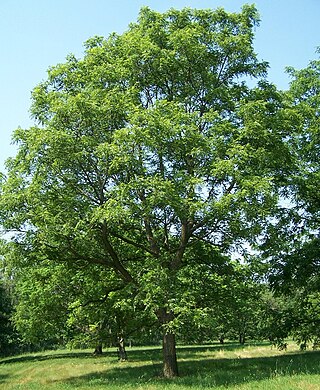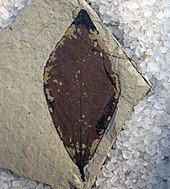
Walnut trees are any species of tree in the plant genus Juglans, the type genus of the family Juglandaceae, the seeds of which are referred to as walnuts. All species are deciduous trees, 10–40 metres (33–131 ft) tall, with pinnate leaves 200–900 millimetres (7.9–35.4 in), with 5–25 leaflets; the shoots have chambered pith, a character shared with the wingnuts (Pterocarya), but not the hickories (Carya) in the same family.

Hamamelidaceae, commonly referred to as the witch-hazel family, is a family of flowering plants in the order Saxifragales. The clade consists of shrubs and small trees positioned within the woody clade of the core Saxifragales. An earlier system, the Cronquist system, recognized Hamamelidaceae in the Hamamelidales order.

Charles Sprague Sargent was an American botanist. He was appointed in 1872 as the first director of Harvard University's Arnold Arboretum in Boston, Massachusetts, and held the post until his death. He published several works of botany. The standard botanical author abbreviation Sarg. is applied to plants he identified.

Juglans regia, the Persian walnut, English walnut, Carpathian walnut, Madeira walnut, or especially in Great Britain, common walnut, is an Old World walnut tree species native to the region stretching from the Balkans eastward to the Himalayas and southwest China. It is widely cultivated across Europe and Caucasus.

The Arnold Arboretum of Harvard University is a botanical research institution and free public park, located in the Jamaica Plain and Roslindale neighborhoods of Boston, Massachusetts. Established in 1872, it is the oldest public arboretum in North America. The landscape was designed by Charles Sprague Sargent and Frederick Law Olmsted and is the second largest "link" in the Emerald Necklace. The Arnold Arboretum's collection of temperate trees, shrubs, and vines has a particular emphasis on the plants of the eastern United States and eastern Asia, where arboretum staff and colleagues are actively sourcing new material on plant collecting expeditions. The arboretum supports research in its landscape and in its Weld Hill Research Building.
Joseph Hers (1884–1965) was a Belgian railroad engineer who served from 1919 to 1924 as a botanist in northern China, where he discovered several new varieties of lilac. Some have been named after him.

Alfred Rehder was a German-American botanical taxonomist and dendrologist who worked at the Arnold Arboretum of Harvard University. He is generally regarded as the foremost dendrologist of his generation.
Albert Charles Smith was an American botanist who served as director of the National Museum of Natural History and Arnold Arboretum and was the former president of the American Society of Plant Taxonomists.

Elmer Drew Merrill was an American botanist and taxonomist. He spent more than twenty years in the Philippines where he became a recognized authority on the flora of the Asia-Pacific region. Through the course of his career he authored nearly 500 publications, described approximately 3,000 new plant species, and amassed over one million herbarium specimens. In addition to his scientific work he was an accomplished administrator, college dean, university professor and editor of scientific journals.
Leonard John Brass was an Australian and American botanist, botanical collector and explorer.

Oakes Ames was an American biologist specializing in orchids. His estate is now the Borderland State Park in Massachusetts. He was the son of Governor of Massachusetts Oliver Ames and grandson of Congressman Oakes Ames.
William Chambers Coker was an American botanist and mycologist.
Peter Shaw Ashton is a British botanist. He is Charles Bullard Professor of Forestry at Harvard University, and director of the Arnold Arboretum there from 1978 to 1987.

Cyril Tenison ("C.T.") White was an Australian botanist.
The Seed Herbarium Image Project (SHIP), is an initiative of the Arnold Arboretum of Harvard University to create a web-based repository of high-resolution digital images documenting the morphology of woody plant seeds and selected fruit structures. Headquartered at the Arboretum’s Dana Greenhouse facility and coordinated and photographed by curatorial assistant Julie McIntosh Shapiro, the Seed Herbarium Image Project supports the work of educators and professionals in horticulture and the botanical sciences, particularly in conservation research and management of rare and endangered species. The digitized images of seeds offer an important new aid for teaching seed identification—a fundamental skill in plant propagation, hybridization, and distribution—and serve as a resource for nurserymen, horticulturists, botanical curators, taxonomists, ecologists, and the general public. SHIP also provides an online resource for botanical institutions and nurseries to verify their collections and inventories. SHIP is made possible through the generous support of the Stanley Smith Horticultural Trust, Cabot Family Charitable Trust, and the J. Frank Schmidt Family Charitable Foundation.
Grady Linder Webster (1927–2005) was a plant systematist and taxonomist. He was the recipient of a number of awards and appointed to fellowships of botanical institutions in the United States of America. Webster's research included study of the diverse family Euphorbiaceae (spurges), on which he produced many papers, and he lectured on plant systematics, biogeography, and the ecology of pollination. Webster's career as a plant systematist was distinguished by the field research he undertook in remote tropical areas.

Frank Nicholas Meyer was a United States Department of Agriculture explorer who traveled to Asia to collect new plant species. The Meyer lemon was named in his honor.
Lily May Perry (1895-1992) was a Canadian-American botanist who worked at Arnold Arboretum and is most known for detailed compilation of information on medicinal plants of East and Southeast Asia and her assistance with the Flora of New Guinea. Perry also has the legacy of authoring the third highest number of land plant species among female scientists, in total naming 414 species.
Theodore ("Ted") Robert Dudley (1936–1994) was an American botanist, who died prematurely of a brain tumor.
Susan Adams Delano McKelvey (1883–1964) was an American botanist and writer, noted for her work at the Arnold Arboretum. The standard author abbreviation McKelvey is used to indicate this person as the author when citing a botanical name.










